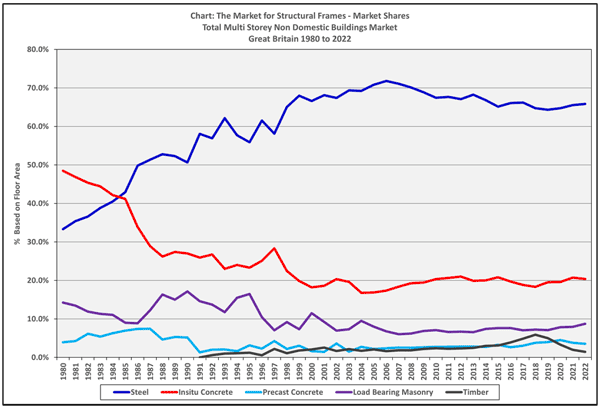Steelwork further strengthens its structural frame market share and pushes forward with sustainability
Structural steel frames continue to be the material of choice, whilst leading the way in sustainable construction.
‘The overall structural frames market in the UK for 2022 was up 6.7% which highlights that the post-pandemic recovery is continuing.’ Said BCSA Chief Executive Officer David Moore.
Steelwork’s overall market share was the biggest of any material. It currently stands at 45.4% of the structural frame market.
“With the total UK consumption of constructional steel in 2022 rising 11.7% to 894,000 tonnes against a backdrop of 6.7% growth in the overall frames market, it is clear that steel has out-performed other framing materials and grown its market share across a broad range of sectors.” Said David.
Steel pushes forward with sustainability credentials
Steel is one of the most sustainable construction materials, and some manufacturing plants have begun greener steelmaking processes.
Before we look at the most sustainable types of structural steel, it’s important to highlight the overall sustainability benefits of specifying steel frames.
• Steel is infinitely recyclable
Steel is well known for being a strong, reliable and long-lasting construction material.
It is also infinitely recyclable. And when scrap steel is smelted, it retains its material properties and value. This means that it is far less likely to end up in landfill, unlike other construction materials that can’t be recycled.
• Structural steel frames are easier to adapt for potential future changes
‘Reduce Reuse Recycle’ has become a modern-day mantra, as construction professionals strive to minimise environmental impact.
Steel frames are adaptable and with careful planning, you can minimise the emissions created by the construction process. Steel frames can help towards less waste, less material and designing for the long haul.
Buildings with structural steel are more adaptable to potential future changes that could be required when the needs of a building evolve over time. For example, office buildings often include flexible floorplates to make the structure easier to adapt for usage changes.
Overall, steel frames have a lower embodied carbon footprint than concrete
While concrete is the largest contributor to embodied carbon in the build environment, steel is amongst the most environmentally friendly construction materials. This is partly because steel has a lower embodied carbon impact and it generates less waste.
Concrete can be reused by grinding it up and then using screens, magnets and water to separate materials. Then it can be used as an aggregate or gravel.
EAF steelmaking has 80% less emissions than BOS
Unlike BOS steel, that is made from raw virgin materials, EAF steel is made from up to 100% scrap steel, using electricity.
EAF steel is also more environmentally friendly because it doesn’t require large amounts of fuel for combustion. Nor does it need the continuous addition of coke to the molten metal to achieve high purities.
Therefore, the overall carbon footprint of EAF is around 20% that of BOF steelmaking. For more information about the manufacturing processes, see our article Understanding steel manufacturing methods.
To effectively reduce embodied carbon, both on current projects and future works, employing the expertise and skills of specialist subcontractors is key.
Contact us today for guidance and advice on your projects.

